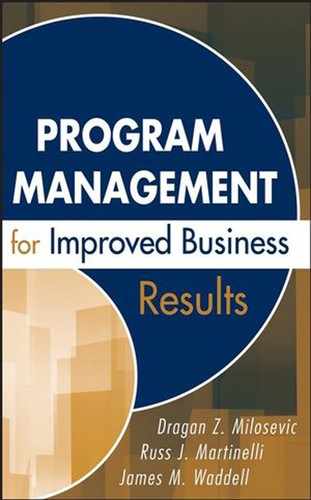During the course of this book, we have explored five stages of program management. First, we explained what program management is and then what and how it helps the organization accomplish their business strategies. We also addressed the need to align organizational business strategies with program operations and to illustrate how program management aids the company in delivering the winning value proposition in the form of the whole product.
We then detailed the process of defining, planning, and executing a single program and explained how program management metrics and tools are enforcers for successful execution of programs. Next we turned attention toward the program manager in which we explored the roles, responsibilities, and core competencies needed to successfully manager a program. Finally, we showed how a transition to program management can be executed in an enterprise and how a PMO can serve as both a business function and operational support organization for the program management discipline.
We now have one stage remaining. Part VI demonstrates through comprehensive case examples how program management is applied in four real-world examples. In the four cases that follow, we look at multiple elements of program management as they interact in more complex examples and contexts than the focused industry examples contained in the previous parts of the book.
In designing this section, we looked at multiple program characteristics such as industry, program size and nature, and program phases. The examples are from different industries, specifically, high-tech manufacturing, software product development, space exploration, and IT. While one company adapts a hardware product for a new market, another develops a new software product; still another organization is attempting to identify terrestrial planets in the universe; while the last looks at the design and deployment of an IT solution in a hospital. The size of the programs varies from 1 million to more than 400 million U.S. dollars.
American Shogun, Appendix A, shows how program management is made simple in a high-tech company when the fundamental principles of the discipline are followed. The teams' dedication to coordinated collaboration between projects, focus on business goals and the bottom line, understanding of cross-project dependencies, and effectively utilizing horizontal- and vertical-management techniques are things we have observed in well-managed programs. Sure, nearly every program experiences at least one crisis, and Shogun is no different, but it is interesting to follow its resolution on a well-run program.
ConSoul Software, Appendix B, is a story about a good company that is also overly ambitious. Under senior management pressure, the program team commits to an unrealistic product feature set and schedule. Two months before the planned customer delivery date, senior management decides to drop two features to recover the schedule slip and hit the announced program launch date. Unfortunately, that is not a simple task at the current phase of the program. Additionally, the program team disagrees with management and prefers to finish the program with the planned 10-feature scope and the related delay because of prelaunch announcements to customers. While sparks fly, management and the program manager meet to resolve the issue.
Planet Orbit, Appendix C, offers a story of the possibility of extraterrestrial life. However, conflict between the scientists and organizational management is highlighted. Senior management ignores the cosmic glory of "to boldly go where no one has gone before," and focuses on earthly issues of schedule delay and cross-site organization. After waiting for more than 10 years for funding of the program, the scientists are not willing to see it stopped and are ready for a fight.
In General Public Hospital, Appendix D, the program team wants to make what it considered to be a big change. However, the program hits a stalemate at the baseline gate review, in which senior management is considering the cancellation of the program. Creative thinking on the part of the program manager breaks the stalemate and brings the possibility of approval to progress to the next phase of the PLC.
